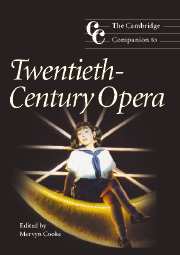4 - Words and actions
from Part two - Trends
Published online by Cambridge University Press: 28 September 2011
Summary
Subject-matter in twentieth-century opera has been shaped by influences as divergent as psychoanalysis, the cinema and television, the preference of many composers for chamber opera, the abandonment of verse or rhymed texts as the standard libretto, and an ironic scrutiny of the form of opera itself. ‘Can I find [an ending] that is not trivial?’, the Countess asks at the close of Strauss's last opera, Capriccio (1942). The problem of triviality confronted many composers after Wagner, whose music-dramas appeared as the pinnacle of operatic development. In the new century it was questionable whether opera as a viable art-form had not been consumed alongside Tristan and Isolde in the passion of the ‘Liebestod’, or the Teutonic gods in the fiery collapse of Der Ring des Nibelungen.
One solution was to make triviality itself into an operatic subject, as Křenek so successfully did with his Zeitoper, Jonny spielt auf (1927), which closes with the image of the black jazz violinist Jonny fiddling astride the globe. Another was to absorb Wagner's musical techniques and dramatic ideals into nationally inflected works: Debussy's Pelléas et Mélisande (1902) owes much to Wagner, but its speech-melody closely resembles the contours of spoken French. A letter Debussy wrote to Ernest Chausson on 2 October 1893 shows how concerned he was to discover a Wagnerian element ‘appearing in the corner of a bar’ (Lesure and Nichols 1987, 54).
- Type
- Chapter
- Information
- The Cambridge Companion to Twentieth-Century Opera , pp. 45 - 59Publisher: Cambridge University PressPrint publication year: 2005



